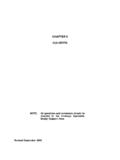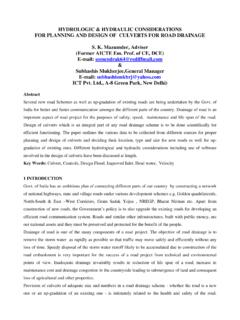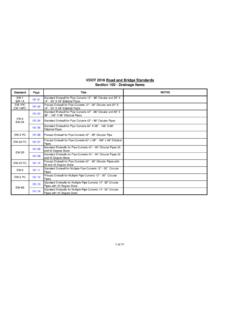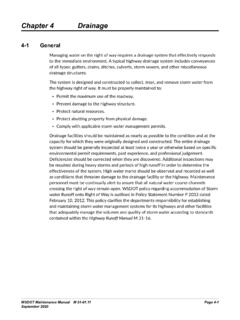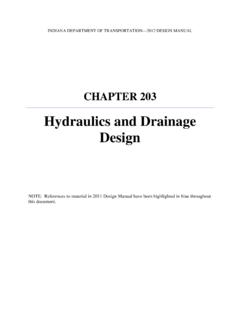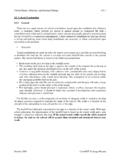Transcription of 4.2 Structural Design of Culverts 4.2.1 Introduction
1 culvert Repair, Materials, and Structural Design 2000 ConnDOT drainage Structural Design of Design of a culvert must be performed to ensure that the culvert is strong enough toresist the loads that will be imposed upon it. The strength of a culvert depends on the strength of thematerials that are used and the shape of the culvert barrel. For example, a circular shape carries andresists loads differently than a box addition to fulfilling their hydraulic functions, Culverts must also support the weight of theembankment or fill covering the culvert and loads on the roadway. There are two general types ofloads that must be carried by Culverts : dead loads and live loads. The amount of both dead and liveload that is actually exerted on a culvert depends upon whether it is a rigid or flexible material, theheight of the embankment above the culvert , the type of material surrounding the culvert , the degreeof compaction of the material, and whether special types of Structural members are built around theculvert to resist and distribute soil loads on a culvert include the earth load or weight of the soil over the culvert and anyadded surcharge loads such as buildings or additional earth fill placed over or adjacent to the culvertalignment.
2 The live loads on a culvert include the loads and forces that act upon the culvert due tovehicular or pedestrian traffic plus an impact factor. Actual loads for specific cases are assigned bythe designer. The effect of live loads decreases as the height of cover over the culvert increases. Forsingle-span Culverts , the effects of live load may be neglected where the depth of fill is more than2400mm (8 ft) and exceeds the span length; for multiple span Culverts , the effects may be neglectedwhere the depth of fill exceeds the distance, between faces of endwalls. Loading determinationsshould follow the procedures set forth in AASHTO LRFD Bridge Design specifications with an earth load of 2000 kg/m3 (125 pounds per cubic foot) if the actual weight of earth is culvert BehaviorA flexible culvert is a composite structure made up of the culvert barrel and the surroundingsoil. The barrel and the soil are both vital elements to the Structural performance of the pipe has relatively little bending stiffness or bending strength on its own.
3 As loads areapplied to the culvert , it attempts to deflect. In the case of a round pipe, the vertical diameterdecreases and the horizontal diameter increases, as shown in Figure culvert Repair, Materials, and Structural DesignConnDOT drainage ManualOctober 2000 Figure 4-4 Deflection of flexible good embankment material is well compacted around the culvert , the increase inhorizontal diameter of the culvert is resisted by the lateral soil pressure. With round pipe, the resultis a relatively uniform radial pressure around the pipe that creates a compressive thrust in the pipewalls. As illustrated in Figure 4-5, the compressive thrust is approximately equal to verticalpressure times one-half the span length (C = P X S/2 or C = P X R).An arc of a flexible round pipe or other shape will be stable as long as adequate soil pressuresare achieved, and as long as the soil pressure is resisted by the compressive force C on each endof the arc.
4 Good quality backfill material and proper installation are critical in obtaining a stablesoil envelope around a flexible Repair, Materials, and Structural Design 2000 ConnDOT drainage ManualFigure 4-5 Formula for ring compressionIn long span Culverts the radius ( R ) is usually large. To prevent excessive deflection due todead and/or live loads, longitudinal or circumferential stiffeners are sometimes added. Thecircumferential stiffeners are usually metal ribs bolted to the outside of the culvert . Longitudinalstiffeners are reinforced concrete, as shown in Figure 4-6. The thrust beams are added to thestructure when backfill reaches their location. The use of concrete stress-relieving slabs isanother method used to achieve longer spans or reduce minimum cover. A stress-relieving slab iscast over the top of the backfill above the structure to distribute live loads to the adjacent 4-6 Concrete thrust beam used as a longitudinal culvert Repair, Materials, and Structural DesignConnDOT drainage ManualOctober culvert BehaviorThe load carrying capacity of rigid Culverts is essentially provided by the Structural strength ofthe pipe itself and little benefit from the surrounding earth is required.
5 When vertical loads areapplied to a rigid pipe, zones of tension and compression are created as illustrated in Figure the exception of non-reinforced circular pipe, reinforcing steel is added to the tension zones toincrease the tensile strength of concrete pipe. Shear stress in the haunch area can be critical forheavily loaded rigid pipe on hard foundations, especially if the haunch support is rigid pipe is stiffer than the surrounding soil, it carries a substantial portion of the 4-7 Zones of tension and compression in rigid pipesThe weight of each that must be carried varies with soil characteristics and installationconditions. The installation conditions can have a significant influence on the loads that must becarried by a rigid culvert . There are two major classes of installation conditions: 1) trench, whereculverts are placed in natural ground or compacted fill with a controlled trench width and 2)embankment, where Culverts are placed in or covered by an narrow trench installations, the pipe is placed in a relatively narrow trench and coveredwith backfill material.
6 The backfill tends to settle more than the undisturbed soil beside thetrench. Friction between the backfill material and the sides of the trench tends to help supportthe backfill material, reducing the load on the pipe. In effect the width of the soil column overthe pipe is decreased. This concept is illustrated in Figure Repair, Materials, and Structural Design 2000 ConnDOT drainage ManualFigure 4-8 Trench installation. Friction on trench sides reduces the size of the columnof fill carried by the the trench width increases, the effect of the friction at the sides of the trench is reduced anddead load on the pipe is increased. The amount that the loading is increased depends on trenchwidth and the amount of backfill settlement, which is related to compaction. Poorly compacted soilwill settle more than well compacted soil.
7 In a trench that is too wide, poor compaction can resultin an increase in the dead load on the pipe. Pipes placed in a shallow bedding on top of the originalground surface and then covered by the embankment material will have loads similar to the verywide trench. Pipes placed in trenches in the original ground prior to being covered by embankmenthave reduced earth loads similar to those described for the narrow Structural condition is a very important element in the performance of Culverts ,durability problems are probably the most frequent cause of replacement. Culverts are morelikely to wear away than fail structurally. Durability is affected by two mechanisms: corrosionand abrasion. Each are discussed in the following sections:CorrosionCorrosion is the deterioration of metals due to chemical or electrochemical reaction to theenvironment. Corrosion of culvert materials may occur in many different soils and waters.
8 Thesesoils and waters may contain acids, alkalis, dissolved salts, organics, industrial wastes or chemicals,mine drainage , sanitary effluents, and dissolved or free gases. However, culvert corrosion isgenerally related to water and the chemicals that have reacted to, become dissolved in, or beentransported by the soil and water conditions have been found to be particularly aggressive or hostile toculverts. Extremes in acidity or alkalinity are much more aggressive than more neutral term pH is a measure of the relative acidity or alkalinity: is neutral, values less than culvert Repair, Materials, and Structural DesignConnDOT drainage ManualOctober 2000acid, and values greater than are alkaline. For culvert purposes, values of less than arestrongly acid and those greater than are strongly alkaline.
9 Acid water stems from two sources:mineral and organic. Mineral acidity comes from sulfurous wells and springs and drainage fromcoal mines, with water containing dissolved sulfur and iron sulfide that may form sulfurous andsulfuric acids. Mineral acidity with a pH as strong as has been encountered. Organic acidity,which may be found in swampy land and barnyards, may have a pH as low as Alkalinity inwater is caused by strong minerals and limed and fertilized fields. Acid water is more common towet climates and alkaline water is more common to dry with pH, water resistivity (R) is an effective way to measure how aggressive the water schemistry may be. Resistivity of low flow samples can accurately predict the potential corrosivity ofdrainage runoff. Resistivity above 1500 ohm-cm are considered normal. Resistivity between 500-1500 ohm-cm are considered below normal.
10 Resistivity below 500 ohm-cm should be electrical resistivity of soil, which depends largely on the nature and amounts of dissolvedsalts, also influences the potential for corrosion. The greater the resistance the less the flow ofelectrical current associated with corrosion. High moisture content and temperature lower theresistivity and increase the potential for corrosion. The use of granular backfill around the entirepipe will increase electrical resistivity and reduce the potential for galvanic can attack the inside or outside of the culvert barrel. The chemicals in drainage watercan attack the material on the interior of the culvert . Culverts subject to continuous flows orstanding water with aggressive chemicals are more likely to be damaged than those withintermittent flows. The exterior of Culverts can be attacked by chemicals in the ground water thatcan originate in the soil, be introduced through contaminates in the backfill soil, or be transported bysubsurface affects all metals and alloys, although the rates can vary widely depending both uponthe chemical and physical properties of the metal and upon the environmental condition to which itis exposed.










